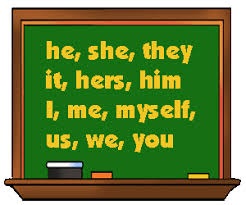|
|
| |
|
|
| |
|
|
|
|
| |
 |
| A few examples of
pronouns. |
Pronouns
A pronoun is traditionally a part of speech in grammar,
but many modern linguists call it a type of noun. In
English, pronouns are words such as me, she, his, them,
herself, each other, it, what.
Pronouns are often used to take the place of a noun, to
avoid repeating the noun. For example, instead of saying
Tom has a new dog.
Tom has named
the
dog Max and Tom lets
the dog sleep by
Tom's bed.
it is easier to say
Tom has a new dog.
He has named
it
Max and he lets
it sleep by
his bed.
When a pronoun replaces a noun, the noun is called the
antecedent. For example, in the sentence: The dog that was
walking down the street, the relative pronoun is the word
that referring back to the antecedent, the word 'dog'. In
the sentence The spy who loved me, the relative pronoun is
the word 'who' and its antecedent is the word 'spy'. |
|
Differences and similarities
to nouns
Pronouns are different from common nouns because
pronouns normally do not come after articles or other
determiners. For example, people do not say "the it".
Pronouns rarely come after adjectives. They are also
different because many of them change depending on how
they are used. For example, "we" is a 'subject' in
grammar, but the word changes to us when used as an
object.
Pronouns are the same as nouns because they both change
for number (singular & plural), case (subject, object,
possessive, etc.), and gender (male, female, animate,
inanimate, etc.) Nouns and pronouns can be used in
almost all the same places in sentences, and they name
the same kinds of things: people, objects, etc. Even
though they can not normally come after determiners, or
adjectives, neither can proper nouns.
Kinds of pronouns
There are four kinds of pronouns: personal, reciprocal,
interrogative, and relative. |
|
|
|
Kinds of English pronouns
|
|
personal
|
you love them
|
Your sister loves herself
|
|
reciprocal
|
we like each other
|
we are looking at one another
|
|
interrogative
|
who is there?
|
what happened?
|
|
relative
|
the person who saw it
|
the time which you told me
|
|
|
Personal pronouns in English
This table shows all the personal pronouns in English
that are commonly used today. |
|
|
|
Personal pronouns in English
|
|
|
Singular
|
Plural
|
|
Subject
|
Object
|
Possessive
|
Reflexive
|
Subject
|
Object
|
Possessive
|
Reflexive
|
|
First
|
I
|
me
|
my, mine
|
myself
|
we
|
us
|
our, ours
|
ourselves
|
|
Second
|
you
|
you
|
your, yours
|
yourself
|
you
|
you
|
your, yours
|
yourselves
|
|
Third
|
Feminine
|
she
|
her
|
her, hers
|
herself
|
they
|
them
|
their, theirs
|
themselves
|
|
Masculine
|
he
|
him
|
his
|
himself
|
|
Neuter
|
it
|
it
|
its
|
itself
|
|
|
A subject pronoun can replace a noun that is the subject
of a sentence. Refer to the table above; the subject
pronouns are: I, You, He, She, It, We, They. An object
pronoun can replace a noun that is the object of a
sentence. A possessive pronoun shows who or what a noun
belongs to.
Another type of personal pronoun is called the
'reflexive pronoun'. Reflexive pronouns are the words
ending in '-self' or '-selves', such as: myself, itself,
themselves.
"It" and its other forms "its", and "itself" only refer
to objects, not people. "They" and its other forms
"them", "their", and "theirs" can be used as a singular,
for a person who could be either male or female. For
example: "The patient will be told how much they will be
required to pay." |
|
|
 Kiddle: Pronouns Kiddle: Pronouns
Wikipedia: Pronouns |
|
|
|
|
|
|
|
|
|
|
|
|
|
|
|
|
Search Fun Easy English |
|
|
|
|
|
|
|
|
|
|
|
|
|
|
|
About
Contact
Copyright
Resources
Site Map |